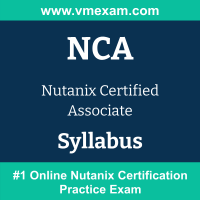 The Nutanix NCA exam preparation guide is designed to provide candidates with necessary information about the Nutanix Certified Associate exam. It includes exam summary, sample questions, practice test, objectives and ways to interpret the exam objectives to enable candidates to assess the types of questions-answers that may be asked during the Nutanix Certified Associate (NCA) exam.
The Nutanix NCA exam preparation guide is designed to provide candidates with necessary information about the Nutanix Certified Associate exam. It includes exam summary, sample questions, practice test, objectives and ways to interpret the exam objectives to enable candidates to assess the types of questions-answers that may be asked during the Nutanix Certified Associate (NCA) exam.
It is recommended for all the candidates to refer the NCA objectives and sample questions provided in this preparation guide. The Nutanix Certified Associate certification is mainly targeted to the candidates who want to build their career in Associate Level domain and demonstrate their expertise. We suggest you to use practice exam listed in this cert guide to get used to with exam environment and identify the knowledge areas where you need more work prior to taking the actual Nutanix Certified Associate exam.
Nutanix NCA Exam Summary:
|
Exam Name
|
Nutanix Certified Associate |
| Exam Code | NCA |
| Exam Price | $99 USD |
| Duration | 90 minutes |
| Number of Questions | 50 |
| Passing Score | 3000 on a scale of 1000-6000 |
| Recommended Training / Books | Nutanix Hybrid Cloud Fundamentals (NHCF) |
| Schedule Exam | Nutanix |
| Sample Questions | Nutanix NCA Sample Questions |
| Recommended Practice | Nutanix Certified Associate (NCA) Practice Test |
Nutanix Certified Associate Syllabus:
| Section | Objectives |
|---|---|
| Describe Lifecycle Management |
- Describe Life Cycle Manager (LCM) Knowledge:
- Monitor LCM software and firmware upgrades
|
| Describe Nutanix Basic Administration |
- Describe how to perform basic VM tasks Knowledge:
- Identify cluster-level settings
- Determine cluster license level
|
| Maintain the Environmental Health of a Nutanix cluster environment |
- Perform and interpret a health check Knowledge:
- Administer alerts, events, and policies
- Create a support ticket
|
| Describe Cluster Configuration Options |
- Determine and describe redundancy/replication factors Knowledge:
- Identify storage components
- Identify storage optimization
- Identify the supported hypervisors
- Identify basic AHV networking
- Determine use cases for Nutanix products and services
|
